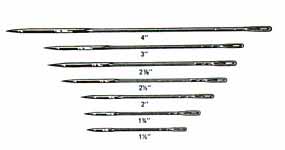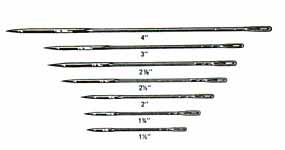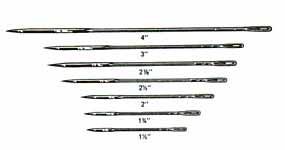Home » Surgical Instruments, Medical Surgical Supplies & Equipment » Abdominal Needles: An Essential Part Of Abdominal Surgical Procedures » Abdominal Needles: An Essential Part Of Abdominal Surgical Procedures
Abdominal Needles: An Essential Part Of Abdominal Surgical Procedures

Keith Abdominal Needles, Straight, Triangular Point, 1-3/4 in
Retail Price: $10.58
Your Price: $7.94
 Unit: 12/package
Unit: 12/package

Keith Abdominal Needles, Straight, Triangular Point, 2-7/8 in
Retail Price: $10.58
Your Price: $7.94
 Unit: 12/package
Unit: 12/package

Keith Abdominal Needles, Straight, Triangular Point, 1-1/2 in
Retail Price: $10.58
Your Price: $7.94
 Unit: 12/package
Unit: 12/package
Abdominal surgery is common in the United States. According to the National Health Statistics Reports there were approximately 14,414,000 surgeries, including major and minor procedures, of the digestive system in 2006. In this group females and people between the ages of 45-64 years old were represented in the highest numbers. This is a decrease of about 2% over the previous year but still one the most common types of surgical procedures performed. Having the right equipment and supplies, including the best possible abdominal needles, can help improve patient recovery rates and prevent complications post procedure that can be a real issue with abdominal surgeries.
More recent information from Datamonitor estimates that the total number of major abdominal surgeries is approximately 7.4 million per year with the number anticipated to rise to 8.1 million by the end of 2020. This includes seven major areas of the world including the United States, France, Germany, the United Kingdom, Japan, Spain and Italy. One of the major factors driving this increase is the aging population around the world. As older patients are typically the age group most represented in abdominal surgical procedures ensuring that there are no complications is critical. This means eliminating any tearing or rupturing of incisions as well as ensuring that all suturing is stable and provides support for the slightly longer healing times required as individuals age.
Having the right size and type of abdominal needles and using the correct type of suture is absolutely critical in any type of major or minor procedure. Although rare, needles can break and leave fragments or pieces that can create significant health risk to the patient. In some cases various types of surgical needles or other types of needles, including those accidentally or intentionally ingested, can cause significant health problems and lead to medical malpractice suits. Using the correct abdominal needle and carefully checking all surgical needles before and after use can eliminate this concern for the surgeon and surgical team.
A top quality surgical needle that is used for abdominal procedures needs to be the correct size and length. Typically the range of lengths for these specialized needles will be between an inch and a half to up to four inches in length. Unlike typical suture needles they have a triangular point that allows easy insertion into all types of tissue found in the abdominal cavity. This provides a smooth passage of the needle through the tissue, eliminating the risk of tissue damage surrounding the entrance and exit points of the suture.
With increased risk of infection due to the non-sterile contents of the digestive system, using both the right abdominal needles as well as the right suture material is imperative. Post-surgical adhesions, which are the fibrous bands of scar tissue that can form during a surgical procedure also need to be minimized. Clean passage of the abdominal needles through the tissue helps to prevent this from becoming an ongoing issue for the patient. In some cases these adhesions may limit the natural movement of the digestive system resulting in lifelong health issues and concerns after a procedure. This is not an uncommon problem for patients. In a 2001 article in the journal Digestive Surgery it was reported by researchers that 90% of patients undergoing open abdominal surgery develop some type of adhesions.
The movement of the abdominal area also poses a problem for post surgical healing. Any additional damage to the tissue can result in tearing of the inner as well as outer layers of the sutures. With the smooth, triangular points on the abdominal needles this risk is reduced and tight, consistent sutures are possible that minimize the risk of any tearing of the incision site with movement.














